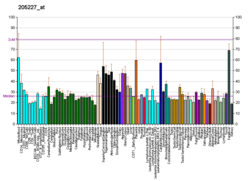Interleukin-1 receptor accessory protein is a protein that in humans is encoded by the IL1RAP gene. [5] [6] [7]
Contents
Interleukin 1 induces synthesis of acute phase and proinflammatory proteins during infection, tissue damage, or stress, by forming a complex at the cell membrane with an interleukin 1 receptor and an accessory protein. This gene encodes an interleukin 1 receptor accessory protein. Alternative splicing of this gene results in two transcript variants encoding two different isoforms, one membrane-bound and one soluble. [7]




